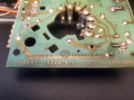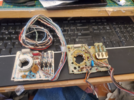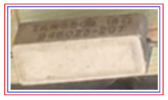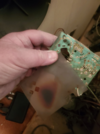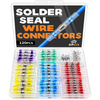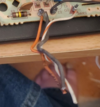zander21510
- Aug 21, 2013
- 4
- Joined
- Aug 21, 2013
- Messages
- 4
Hello, I'm currently trying to restore an old RCA console television to use with my retro game consoles. My uncle found it for me in excellent cosmetic condition, and was apparently used up until a few years ago, taken care of in an old woman's house till she passed away. Sticker on the back says manufactured in 1986, it's a RCA Colortrak 2000- very high end for the day.
So the problem it's having, from the research I've done, seems to be consistent with some bad capacitors. There are some lines on the top of the screen, and it will lose power randomly before coming back on. I would say it works fine 60% of the time, the other 40% the screen goes out for a few minutes, and comes back on intermittently.
I'm fairly comfortable with soldering & I want to try to replace the capacitors, problem is, there are SO MANY and I'm not sure where to start. From my research, I should be looking for bulged or leaking capacitors, but I haven't found any except for just one that seems like it's slightly bulged on the top.
The nice thing about this TV though, is it has a bunch of reference stickers on the inside of the cabinet, that look like diagrams. Over my head for sure, but hopefully someone can make something out of it?
I've attached pictures of the main board inside the cabinet, along with the reference stickers on the side, and circled the one capacitor that seems bulged. If someone could help me pick out a few capacitors to start with to replace, it would help me not pick ones that won't make a difference and reduce the possibility of me messing something up. Let me know if you need more/better pictures or want to see the other boards. Thanks!
Full Cabinet:
 Diagrams
Diagrams




Right side of main board (has a smaller board stacked on top)
 Closer look underneath right side of main board
Closer look underneath right side of main board
 Middle view of main board
Middle view of main board
 Left view of main board
Left view of main board

Circled capacitor is slightly bulged, view of left side of main board

Circled capacitor is slightly bulged, top view of main board.
So the problem it's having, from the research I've done, seems to be consistent with some bad capacitors. There are some lines on the top of the screen, and it will lose power randomly before coming back on. I would say it works fine 60% of the time, the other 40% the screen goes out for a few minutes, and comes back on intermittently.
I'm fairly comfortable with soldering & I want to try to replace the capacitors, problem is, there are SO MANY and I'm not sure where to start. From my research, I should be looking for bulged or leaking capacitors, but I haven't found any except for just one that seems like it's slightly bulged on the top.
The nice thing about this TV though, is it has a bunch of reference stickers on the inside of the cabinet, that look like diagrams. Over my head for sure, but hopefully someone can make something out of it?
I've attached pictures of the main board inside the cabinet, along with the reference stickers on the side, and circled the one capacitor that seems bulged. If someone could help me pick out a few capacitors to start with to replace, it would help me not pick ones that won't make a difference and reduce the possibility of me messing something up. Let me know if you need more/better pictures or want to see the other boards. Thanks!
Full Cabinet:
 Diagrams
Diagrams



Right side of main board (has a smaller board stacked on top)
 Closer look underneath right side of main board
Closer look underneath right side of main board Middle view of main board
Middle view of main board Left view of main board
Left view of main board 
Circled capacitor is slightly bulged, view of left side of main board

Circled capacitor is slightly bulged, top view of main board.

